Numerical Study on Sensitivity of Turbofan Engine Performance to Blade Count of Centrifugal Compressor Impeller
Abstract
1. Introduction
2. Materials and Methods
2.1. Objective and Scope of the Study
- In the first step, the reference test data were collected through a series of virtual engine manoeuvres carried out at WESTT CS/BV. The manoeuvres were run at ISA ambient conditions and a take-off thrust level setup, which eventually led to the establishment of a design point for further research.
- In the second step, the CFD numerical model was developed in ANSYS CFX and then implemented to study the impact of the HPC impeller’s blade number on its performance.
- In the final step, the results of the CFD simulations were utilised as the input dataset to the analytical zero-D model of the entire engine, and the sensitivity of thrust and specific fuel consumption to was assessed.
2.2. DGEN 380 Engine Analytical Model in MATLAB
2.3. Geometric and CFD 3D Model of HPC Impeller
3. Results and Discussion
3.1. Virtual Performance Tests
3.2. Mesh Independence
- Global parameters directly present in the implemented analytical model of the DGEN 380, i.e., HPC total pressure ratio CPR and isentropic efficiency ;
3.3. Influence of Blade Number on the Impeller’s Performance
3.4. Analysis of Engine Performance
- On the isentropic Mach number at the outlet of the core nozzle:
- On the amount of fuel heat power required to support either the condition of or :
4. Conclusions
- The growth in the main blade count from to (overall blade count from to ) resulted in a 2% drop in the total-to-total isentropic compression efficiency.
- The effect of increasing solidity led to an 2.5% incline in the impeller work input between and . At , the aerodynamic loading of the splitters experienced a crisis caused by the highest rate of the inlet area contraction, and the work input fell by 1%.
- The design with was the only one to outperform the baseline from the viewpoint of engine thrust and specific fuel consumption. The room left for improvement, however, was marginal: 0.4% of rise in and 0.3% of fall in .
- The poor performance of the HPC at translated into the worst engine characteristics: 1.4% drop in thrust and 1.3% rise in .
Author Contributions
Funding
Data Availability Statement
Acknowledgments
Conflicts of Interest
Abbreviations
| Latin | |
| Circumferential component of absolute flow velocity (m/s) | |
| Specific heat capacity at constant pressure (J/(kg K)) | |
| Equivalent friction drag coefficient of impeller [44] | |
| CFD | Computational fluid dynamics |
| Compressor pressure ratio (-) | |
| DLR | Deutsches Zentrum für Luft- und Raumfahrt (German Aerospace Center) |
| Approximate relative error [43] | |
| ER | Expansion ratio |
| GA | Genetic algorithm |
| Grid convergence index [43] | |
| GT | Gas turbine |
| HPC | High-pressure compressor |
| HPT | High-pressure turbine |
| I | Work input factor [18] |
| ISA | International Standard Atmosphere |
| Spanwise averaged meridional length of the blade (mm) | |
| Low heating value (J/kg) | |
| Meridional length of the blade at current span (mm) | |
| LPT | Low-pressure turbine |
| Mass flow rate (kg/s) | |
| M | Meridional coordinate (mm), Mach number (-) |
| n | Rotational speed (rev/min) |
| OEM | Original equipment manufacturer |
| r | Grid refinement factor [43] |
| SST | Shear stress transport |
| Streamwise averaged blade pitch computed for cascade with both main and splitter blades (mm) | |
| Tangential velocity at impeller outlet (impeller tip speed, m/s) | |
| VSV | Variable stator vanes |
| WESTT | Whole-engine simulator turbine technology |
| Height of next-to-wall element of the grid (mm) | |
| z | Number of blades (-) |
| Greek | |
| Flow angle in relative frame of reference, measured from tangential direction (deg) | |
| Blade angle at impeller outlet, measured from tangential direction (deg) | |
| Efficiency (-) | |
| Slip factor [18] | |
| Total pressure loss coefficient (-) | |
| Coefficient of area contraction (blade metal blockage, -) | |
| Profile loss coefficient of impeller [44] | |
| Subscripts | |
| 1 | Refers to HPC impeller leading edge location (equal to 26 in engine scale) |
| 2 | Refers to HPC impeller trailing edge location (equal to 27 in engine scale) |
References
- Dixon, S.; Hall, C. Fluid Mechanics and Thermodynamics of Turbomachinery; Butterworth-Heinemann: Oxford, UK, 2010; pp. 68–79. [Google Scholar]
- Campbell, W. The Protection of Steam Turbine Disc Wheels from Axial Vibration. Trans. ASME 1924, 46, 31–160. [Google Scholar]
- Kushner, F. Disc Vibration-Rotating Blade and Stationary Vane Interaction. ASME J. Mech. Des. 1980, 102, 579–584. [Google Scholar] [CrossRef]
- Singh, M.P.; Vargo, J.J.; Schiffer, D.M.; Delio, J.D. SAFE Diagram—A Design and Reliability Tool for Turbine Blading. In Proceedings of the 17th Turbomachinery Symposium, College Station, TX, USA; 1988; pp. 93–102. [Google Scholar] [CrossRef]
- Przysowa, R.; Russhard, P. Non-contact measurement of blade vibration in an axial compressor. Sensors 2020, 20, 68. [Google Scholar] [CrossRef] [PubMed]
- Bednarz, A. Influence of the Amplitude of Resonance Vibrations on Fatigue Life of a Compressor Blade with Simulated FOD Damage. Adv. Sci. Technol. Res. J. 2020, 14, 22–29. [Google Scholar] [CrossRef]
- Milidonis, K.; Semlitsch, B.; Hynes, T. Effect of Clocking on Compressor Noise Generation. AIAA J. 2018, 11, 4225–4231. [Google Scholar] [CrossRef]
- Błaszczak, J. Performance Improvement and Noise Reduction through Vane and Blade Indexing of a Two-Stage Turbine. In Proceedings of the 14th AIAA/CEAS Aeroacoustics Conference (29th AIAA Aeroacoustics Conference), Reston, VA, USA, 5–7 May 2008. [Google Scholar] [CrossRef]
- Stodola, A. Dampf- und Gasturbinen; Springer: Berlin/Heidelberg, Germany, 1924; pp. 144–145, (In German). [Google Scholar] [CrossRef]
- Dejch, M.E.; Filippov, G.A.; Lazarev, L.J. Collection of Profiles for Axial Turbine Cascades; Mashinostroenie: Moscow, Russia, 1965. (In Russian) [Google Scholar]
- Howell, A.R. Fluid Dynamics of Axial Compressors. Proc. Inst. Mech. Eng. 1945, 153, 441–452. [Google Scholar] [CrossRef]
- Cuciumita, C.; Qin, N.; Shahpar, S. Adjoint based aero-structural design optimisation of a transonic fan blade. Proc. Inst. Mech. Eng. Part J. Power Energy 2023. [Google Scholar]
- Rusanov, A.; Subotin, V.; Shvetsov, V.; Rusanov, R.; Palkov, S.; Palkov, I.; Chugay, M. Application of innovative solutions to improve the efficiency of the LPC flow part of the 220 MW NPP steam turbine. Arch. Thermodyn. 2022, 43, 63–87. [Google Scholar] [CrossRef]
- Głuch, S.J.; Ziółkowski, P.; Witanowski, Ł.; Badur, J. Design and computational fluid dynamics analysis of the last stage of innovative gas-steam turbine. Arch. Thermodyn. 2021, 42, 255–278. [Google Scholar] [CrossRef]
- Pakatchian, M.; Saeidi, H.; Ziamolki, A. CFD-based blade shape optimization of MGT-70(3) axial flow compressor. Int. J. Numer. Methods Heat Fluid Flow 2020, 30, 3307–3321. [Google Scholar] [CrossRef]
- Waesker, M.; Buelten, B.; Kienzle, N.; Doetsch, C. Optimization of Supersonic Axial Turbine Blades Based on Surrogate Models. In Proceedings of the ASME Turbo Expo 2020, Virtual, Online, 21–25 September 2020. [Google Scholar] [CrossRef]
- Casey, M.; Robinson, C. Radial Flow Turbocompressors; Cambridge University Press: Campbridge, UK, 2021; p. 379. [Google Scholar] [CrossRef]
- Aungier, R. Centrifugal Compressors: A Strategy for Aerodynamic Design and Analysis; ASME Press: New York, NY, USA, 2000. [Google Scholar]
- Japikse, D. Centrigufal Compressor Design and Performance; Concepts ETI: White River Junction, VT, USA, 1996. [Google Scholar]
- Moroz, L.; Govoruschenko, Y.; Pagur, P.; Romanenko, L. Integrated Conceptual Design Environment for Centrifugal Compressors Flow Path Design. In Proceedings of the ASME 2008 International Mechanical Engineering Congress and Exposition, Boston, MA, USA, 31 October–6 November 2008; pp. 175–185. [Google Scholar] [CrossRef]
- Turner, M.G.; Reed, J.A.; Ryder, R.; Veres, J.P. Multi-Fidelity Simulation of a Turbofan Engine With Results Zoomed Into Mini-Maps for a Zero-D Cycle Simulation. In Proceedings of the ASME Turbo Expo 2004, Vienna, Austria, 14–17 June 2004; pp. 219–230. [Google Scholar] [CrossRef]
- Adamczyk, J.J. Aerodynamic Analysis of Multistage Turbomachinery Flows in Support of Aerodynamic Design. In Proceedings of the ASME Turbo Expo 1999, Indianapolis, IN, USA, 7–10 June 1999; pp. 189–217. [Google Scholar] [CrossRef]
- Claus, R.; Townsend, S.; Lavelle, T.; Turner, M. Coupled Component, Full Engine Simulation of a Gas Turbine Engine. In Proceedings of the 45th AIAA/ASME/SAE/ASEE Joint Propulsion Conference, Reston, VA, USA, 2–5 August 2009. [Google Scholar] [CrossRef]
- Łukasik, B. Turboelectric Distributed Propulsion System As a Future Replacement for Turbofan Engines. In Proceedings of the ASME Turbo Expo 2017, Charlotte, NC, USA, 26–30 June 2017. [Google Scholar] [CrossRef]
- Reitenbach, S.; Schnös, M.; Becker, R.-G.; Otten, T. Optimization of Compressor Variable Geometry Settings Using Multi-Fidelity Simulation. In Proceedings of the ASME Turbo Expo 2015, Montreal, QC, Canada, 15–19 June 2015. [Google Scholar] [CrossRef]
- Klein, C.; Reitenbach, S.; Schoenweitz, D.; Wolters, F. A Fully Coupled Approach for the Integration of 3D-CFD Component Simulation in Overall Engine Performance Analysis. In Proceedings of the ASME Turbo Expo 2017, Charlotte, NC, USA, 26–30 June 2017. [Google Scholar] [CrossRef]
- Klein, C.; Wolters, F.; Reitenbach, S.; Schönweitz, D. Integration of 3D-CFD Component Simulation Into Overall Engine Performance Analysis for Engine Condition Monitoring Purposes. In Proceedings of the ASME Turbo Expo 2018, Oslo, Norway, 11–15 June 2018. [Google Scholar] [CrossRef]
- Petrovic, M.V.; Wiedermann, A. Fully Coupled Through-Flow Method for Industrial Gas Turbine Analysis. In Proceedings of the ASME Turbo Expo 2015, Montreal, QC, Canada, 15–19 June 2015. [Google Scholar] [CrossRef]
- Saini, P.; Defoe, J. The effect of blade count on body force model performance for axial fans. J. Turbomach. 2021, 143, 071011. [Google Scholar] [CrossRef]
- Hall, D.; Greitzer, E.; Tan, C. Analysis of fan stage conceptual design attributes for boundary layer ingestion. J. Turbomach. 2017, 139, 071012. [Google Scholar] [CrossRef]
- Akira Technologies SAS. Available online: https://www.akira.pro/produits-westt/ (accessed on 24 March 2023).
- Pakmehr, M.; Wang, T.; Jobredeaux, R.; Vivies, M.; Feron, E. Verifiable control system development for gas turbine engines. arXiv 2013, arXiv:1311.1885. [Google Scholar]
- Saravanamuttoo, H.; Rogers, G.; Cohen, H. Gas Turbine Theory; Pearson: London, UK, 2017. [Google Scholar]
- Jakubowski, R. Evaluation of performance properties of two combustor turbofan engine. Maint. Durab. 2015, 17, 575–581. [Google Scholar] [CrossRef]
- De Vega, L.L.; Dufour, G.; García Rosa, N. A fully coupled body force-engine performance methodology for boundary layer ingestion. In Proceedings of the AIAA Propulsion and Energy Forum and Exposition, Indianapolis, IN, USA, 19–22 August 2019. [Google Scholar] [CrossRef]
- Asoliman, I.M.; Ehab, M.; Mahrous, A.M.; El-Sayed, A.F.; Emeara, M.S. Performance Analysis of High Bypass Turbofan Engine Trent 1000-A. In Proceedings of the 3rd IUGRC International Undergraduate Research Conference, Military Technical College, Cairo, Egypt, 30 July–1 August 2018. [Google Scholar]
- El-Sayed, A.F. Aircraft Propulsion and Gas Turbine Engines, 2nd ed.; Taylor and Francis CRC Press: Abingdon, UK, 2017. [Google Scholar]
- Sob, P.B.; Pita, M. Modelling and Designing of a Turbofan Engine with More Enhanced Overall Engine Efficiency During Operation. Int. J. Mech. Prod. Eng. Res. Dev. (Ijmperd) 2021, 11, 333–350. [Google Scholar]
- Kurzke, J.; Halliwell, I. Propulsion and Power: An Exploration of Gas Turbine Performance Modeling, 1st ed.; Springer International Publishing AG: Berlin/Heidelberg, Germany, 2018. [Google Scholar] [CrossRef]
- Kurzke, J. Fundamental Differences between Conventional and Geared Turbofans. In Proceedings of the ASME Turbo Expo 2009, Orlando, FL, USA, 8–12 June 2009. [Google Scholar] [CrossRef]
- Jakubowski, R. Modeling and analysis of jet engine with cooling turbine. J. Kones Powertrain Transp. 2012, 19, 235–243. [Google Scholar] [CrossRef]
- Waesker, M.; Goetz, T.; Buelten, B.; Kienzle, N. Analysis of Slip Factors in CFD Calculations-Assessment of Literature Models. In Proceedings of the 14th European Conference on Turbomachinery Fluid Dynamics & Thermodynamics, Gdańsk, Poland, 12–16 April 2021. [Google Scholar] [CrossRef]
- Celik, I.B.; Ghia, U.; Roache, P.J. Procedure for estimation and reporting of uncertainty due to discretization in CFD applications. J. Fluids Eng. 2008, 130, 078001. [Google Scholar]
- Galerkin, Y.; Rekstin, A.; Soldatova, K.; Drozdov, A.; Solovyeva, O.; Semenovskiy, V.; Marenina, L. The Current State of the Engineering Method for the Optimal Gas-Dynamic Design and Calculation of Centrifugal Compressor. Energies 2020, 13, 5651. [Google Scholar] [CrossRef]
- Galerkin, Y. Turbocompressors; KHT: Moscow, Russia, 2010. (In Russian) [Google Scholar]


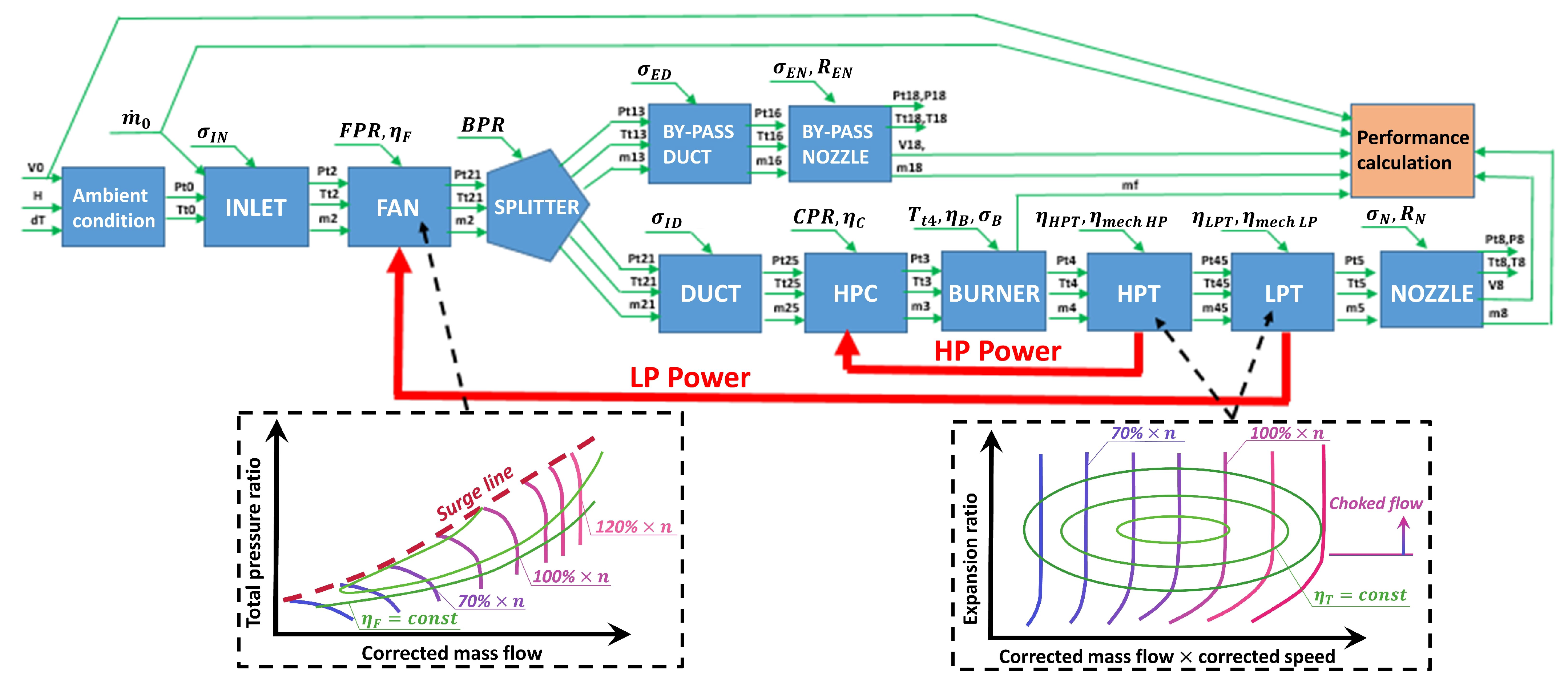
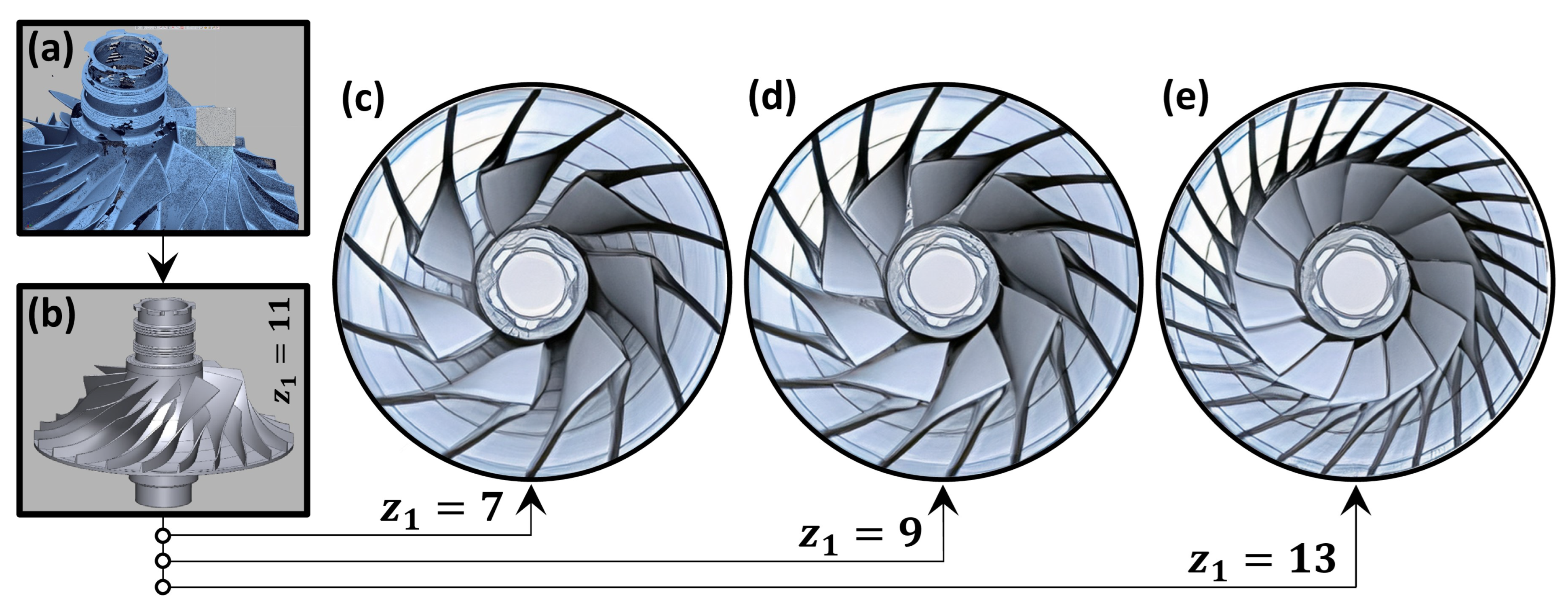
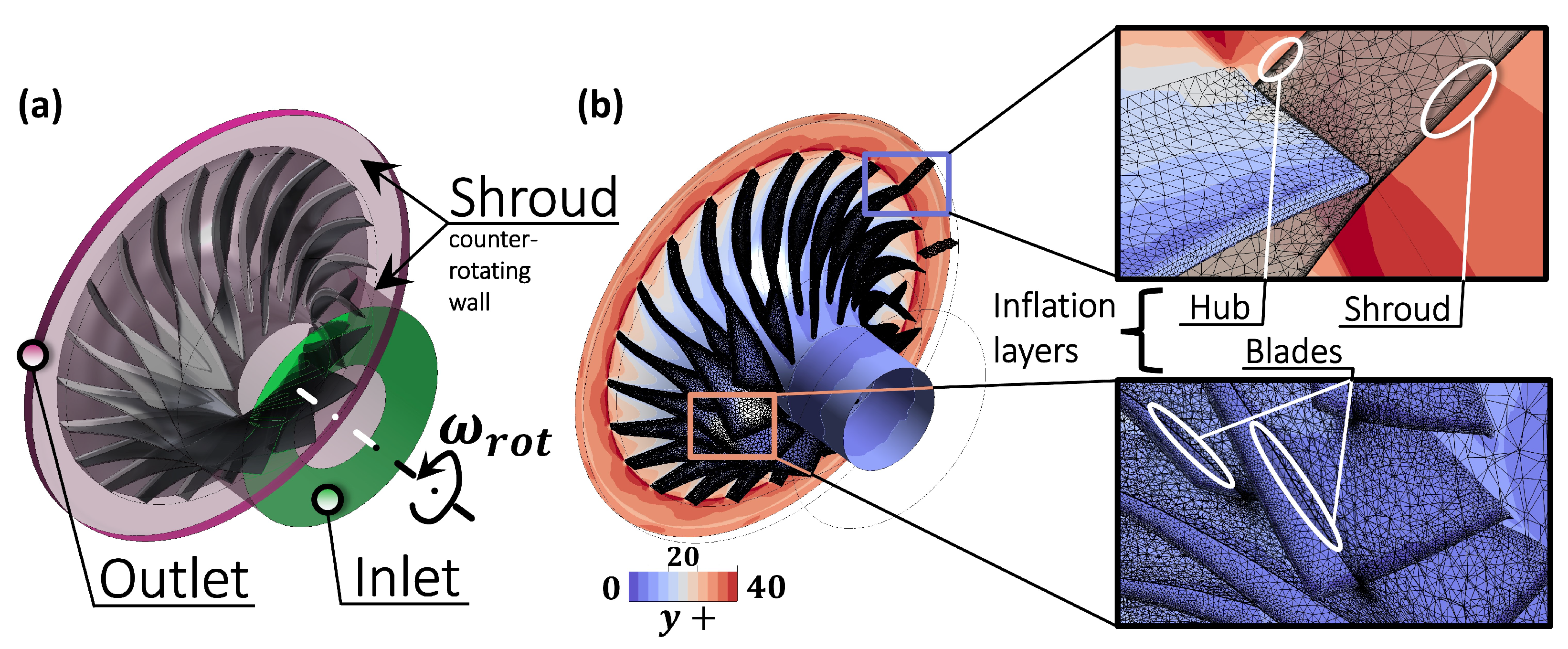
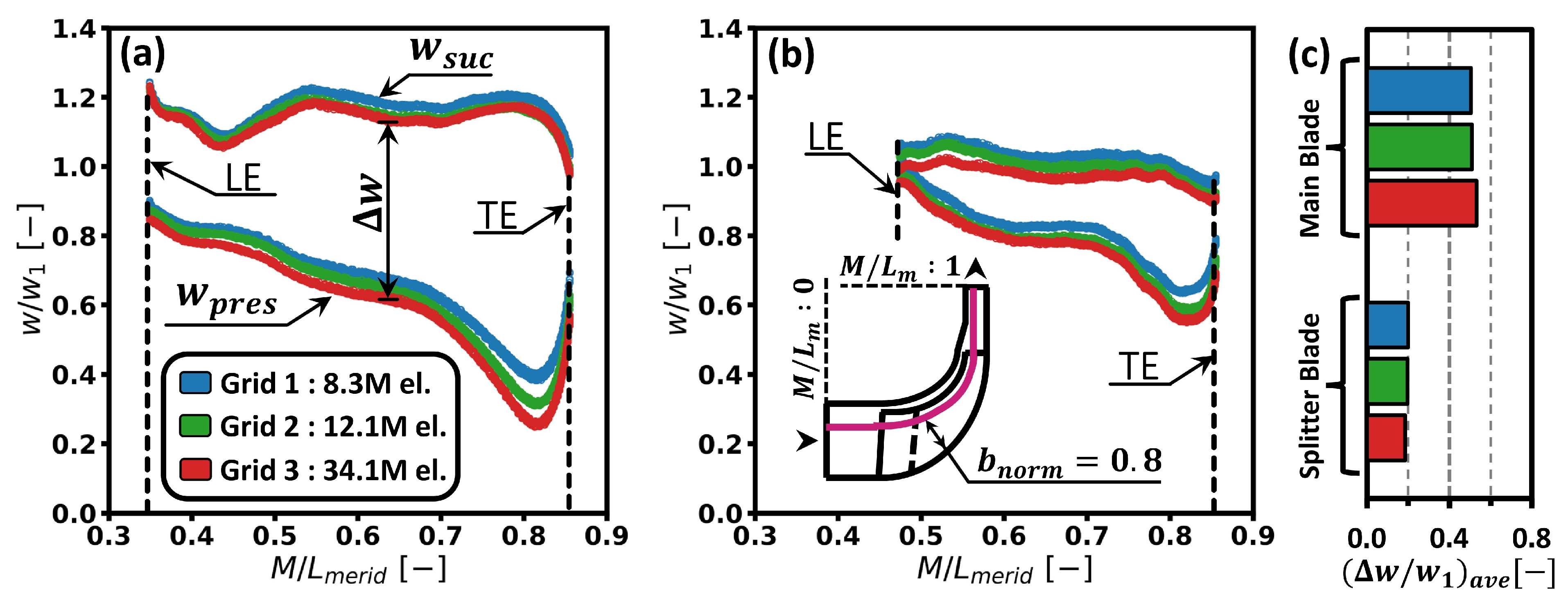
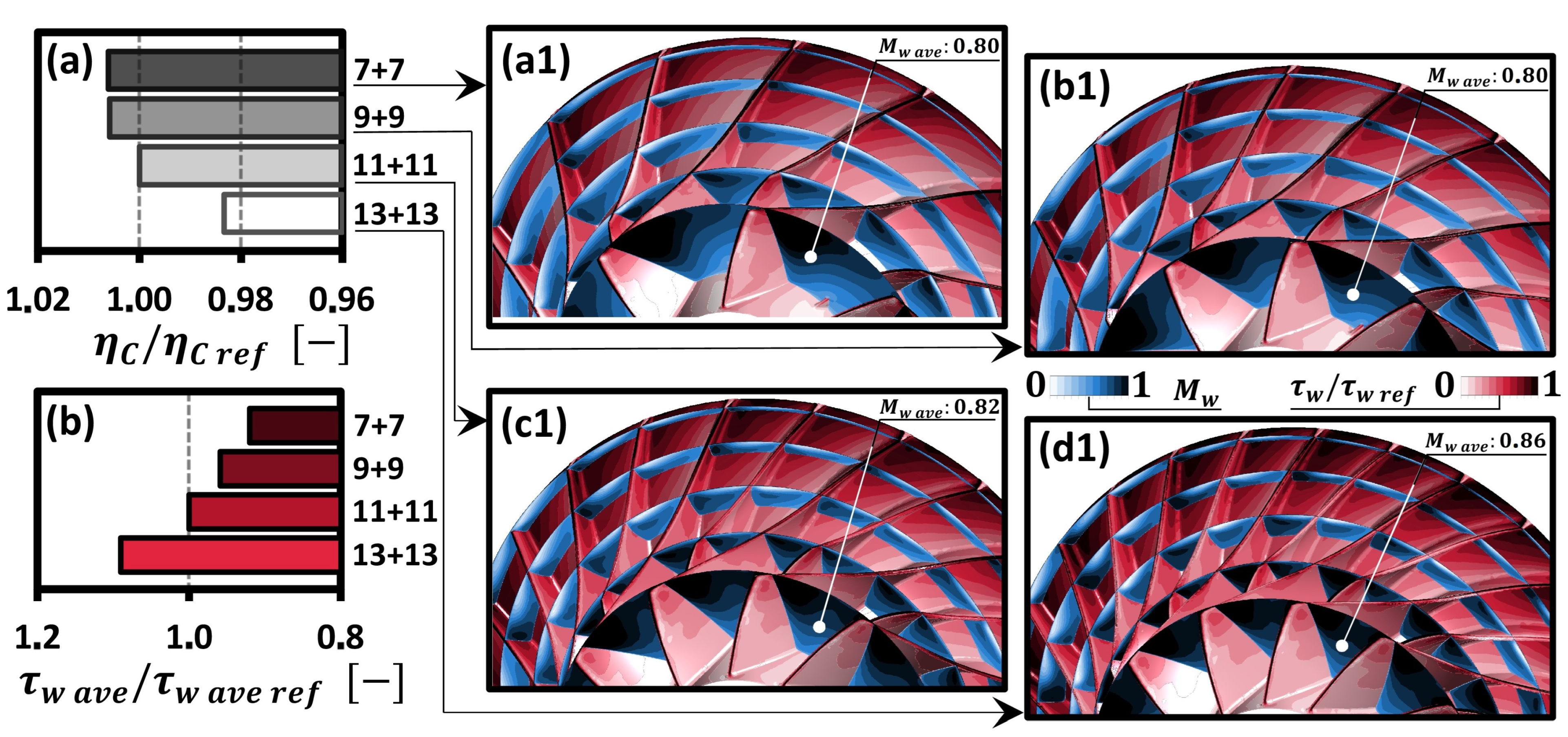


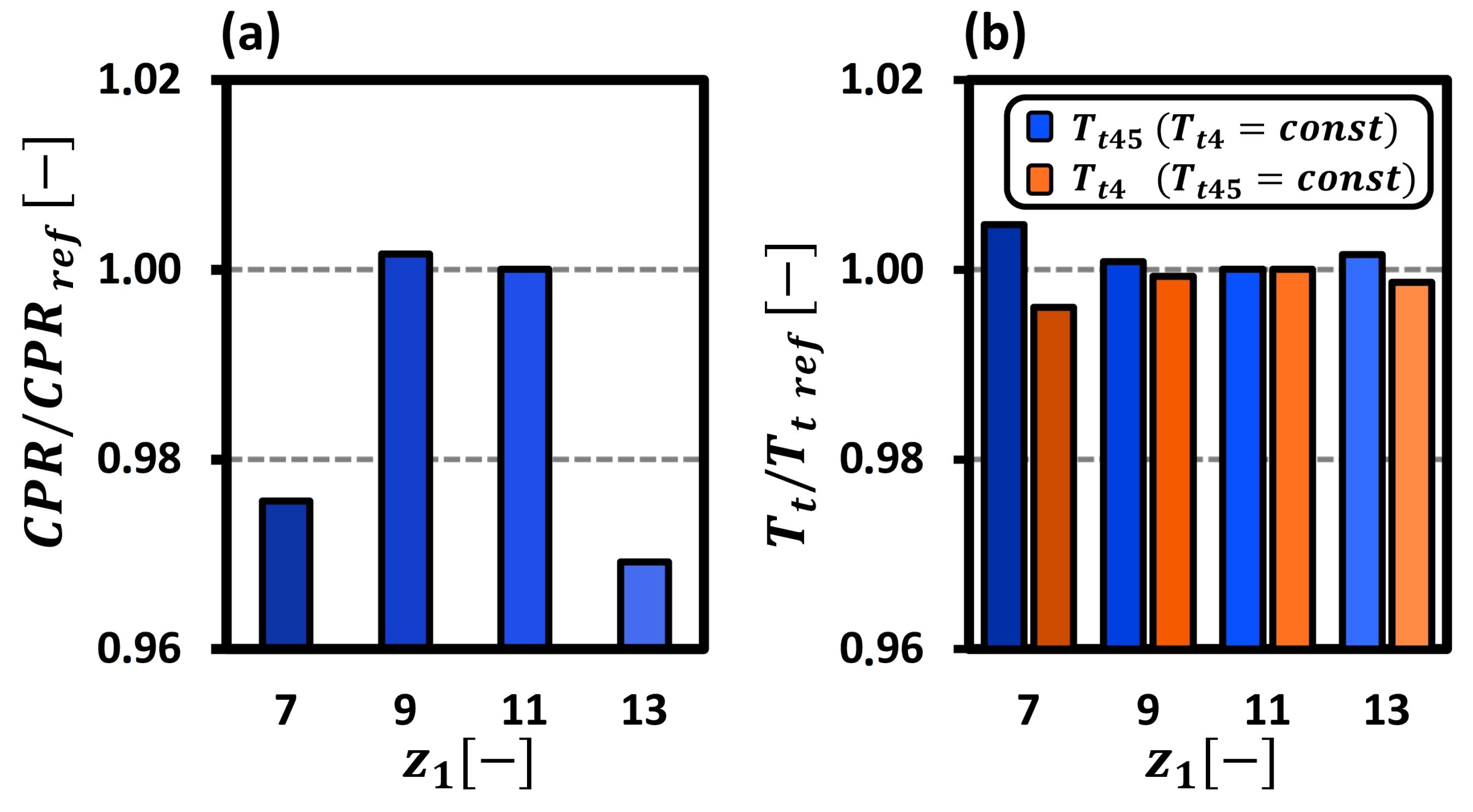
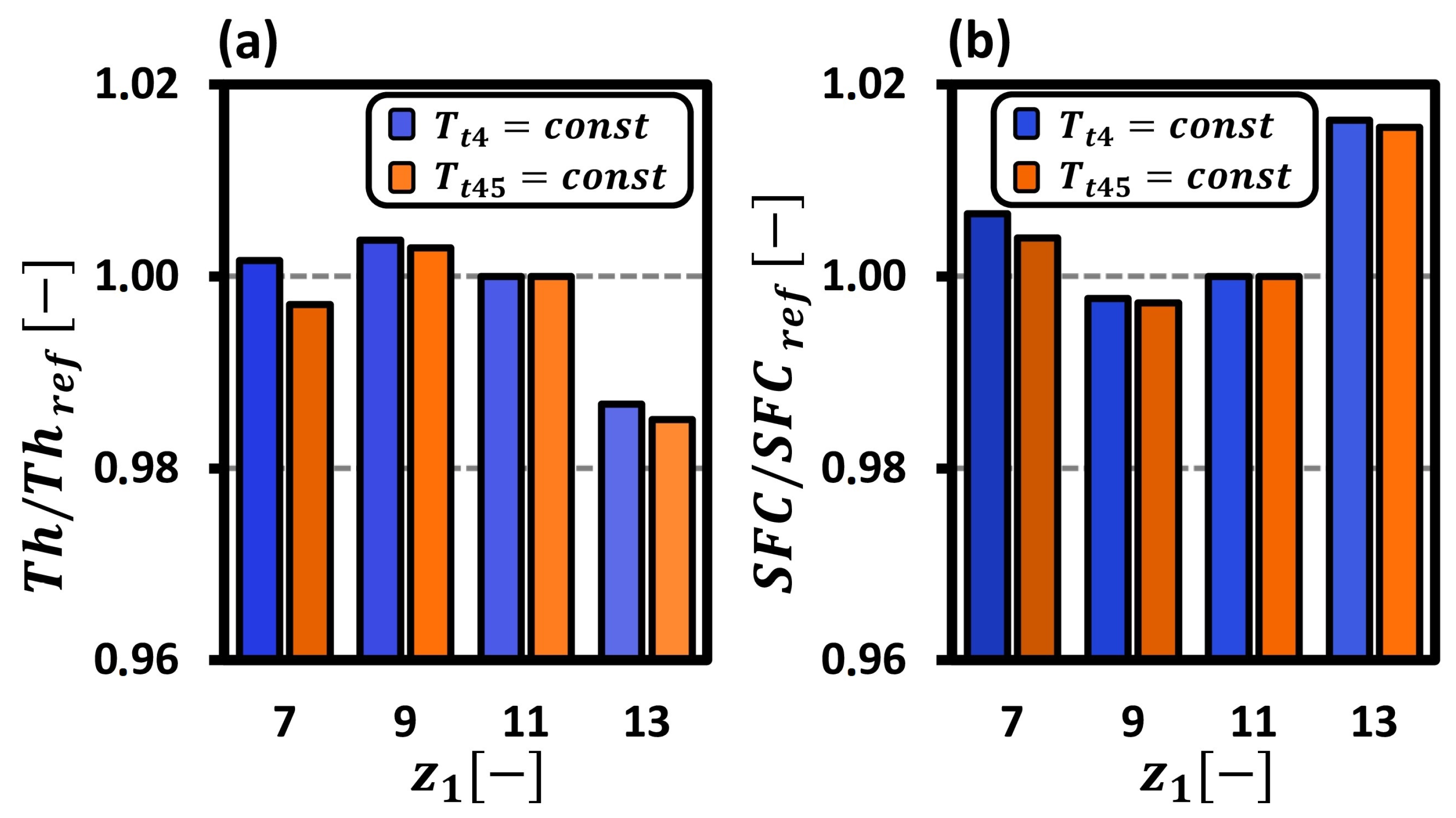
| Blade Config. , − | Impeller Mass , kg | Change in the Mass of Impeller, % | Average Solidity , − | Change in the Outlet Solidity, % |
|---|---|---|---|---|
| 7 | 2.62 | −5.7 | 2.05 | −36.3 |
| 9 | 2.67 | −3.8 | 2.64 | −18.0 |
| 11 | 2.78 | 0.0 | 3.22 | 0.0 |
| 13 | 2.83 | 1.9 | 3.80 | 18.0 |
| Grid | No. of Nodes, | Wall Inflation Data | Blade Tip Res-Tion, tan. dir-n | |||
|---|---|---|---|---|---|---|
| No. of Layers | , mm | ER | No. of el-ts | |||
| Medium | 3.1 | 10 | 0.01 | 1.2 | 3 | 46 |
| Fine | 4.5 | 10 | 0.01 | 1.2 | 5 | 46 |
| Very Fine | 12.3 | 10 | 0.01 | 1.2 | 10 | 45 |
| , kPa | , K | , % | , mm | , kPa | n, rpm |
|---|---|---|---|---|---|
| 116 | 304 | 3 | 4.6 | adjusted to reach kg/s | 51,410 |
| Parameter | Section | ||||||||
|---|---|---|---|---|---|---|---|---|---|
| 1 | 18 | 21 | 25 | 3 | 4 | 45 | 5 | 8 | |
| , kg/s | 13.75 | 11.79 | 1.75 | 1.75 | 1.75 | 1.78 | 1.78 | 1.78 | 1.78 |
| , K | 288.1 | 306.3 | 304.5 | 304.5 | 512.8 | 1170.8 | 990.2 | 867.0 | 867.0 |
| , kPa | 101.2 | 120.8 | 118.7 | 116.3 | 534.5 | 510.2 | 227.0 | 122.2 | 120.0 |
| Thrust , N | Fuel Mass Flow , kg/s | SFC, kg/daN/h | Bypass Ratio |
|---|---|---|---|
| 2491 | 0.031 | 0.454 | 6.75 |
| Efficiencies | Loss Coefficients | ||
|---|---|---|---|
| 0.82 | 0.99 | ||
| 0.80 | 0.95 | ||
| 0.99 | 0.96 | ||
| 0.85 | 0.98 | ||
| 0.87 |
| CPR | I | ||||
|---|---|---|---|---|---|
| 34.1, 12.1, 8.3 | |||||
| 1.41, 1.13 | |||||
| 1.9, 3.0 | 0.8, 1.4 | 0.1, 0.2 | 0.4, 0.7 | 0.6, 1.5 | |
| 0.20, 2.70 | 0.01, 1.00 | 0.01, 0.10 | 0.04, 0.60 | 0.02, 0.70 |
Disclaimer/Publisher’s Note: The statements, opinions and data contained in all publications are solely those of the individual author(s) and contributor(s) and not of MDPI and/or the editor(s). MDPI and/or the editor(s) disclaim responsibility for any injury to people or property resulting from any ideas, methods, instructions or products referred to in the content. |
© 2023 by the authors. Licensee MDPI, Basel, Switzerland. This article is an open access article distributed under the terms and conditions of the Creative Commons Attribution (CC BY) license (https://creativecommons.org/licenses/by/4.0/).
Share and Cite
Bednarz, A.; Kabalyk, K.; Jakubowski, R.; Bartłomowicz, R. Numerical Study on Sensitivity of Turbofan Engine Performance to Blade Count of Centrifugal Compressor Impeller. Energies 2023, 16, 5251. https://doi.org/10.3390/en16145251
Bednarz A, Kabalyk K, Jakubowski R, Bartłomowicz R. Numerical Study on Sensitivity of Turbofan Engine Performance to Blade Count of Centrifugal Compressor Impeller. Energies. 2023; 16(14):5251. https://doi.org/10.3390/en16145251
Chicago/Turabian StyleBednarz, Arkadiusz, Kirill Kabalyk, Robert Jakubowski, and Rafał Bartłomowicz. 2023. "Numerical Study on Sensitivity of Turbofan Engine Performance to Blade Count of Centrifugal Compressor Impeller" Energies 16, no. 14: 5251. https://doi.org/10.3390/en16145251
APA StyleBednarz, A., Kabalyk, K., Jakubowski, R., & Bartłomowicz, R. (2023). Numerical Study on Sensitivity of Turbofan Engine Performance to Blade Count of Centrifugal Compressor Impeller. Energies, 16(14), 5251. https://doi.org/10.3390/en16145251








